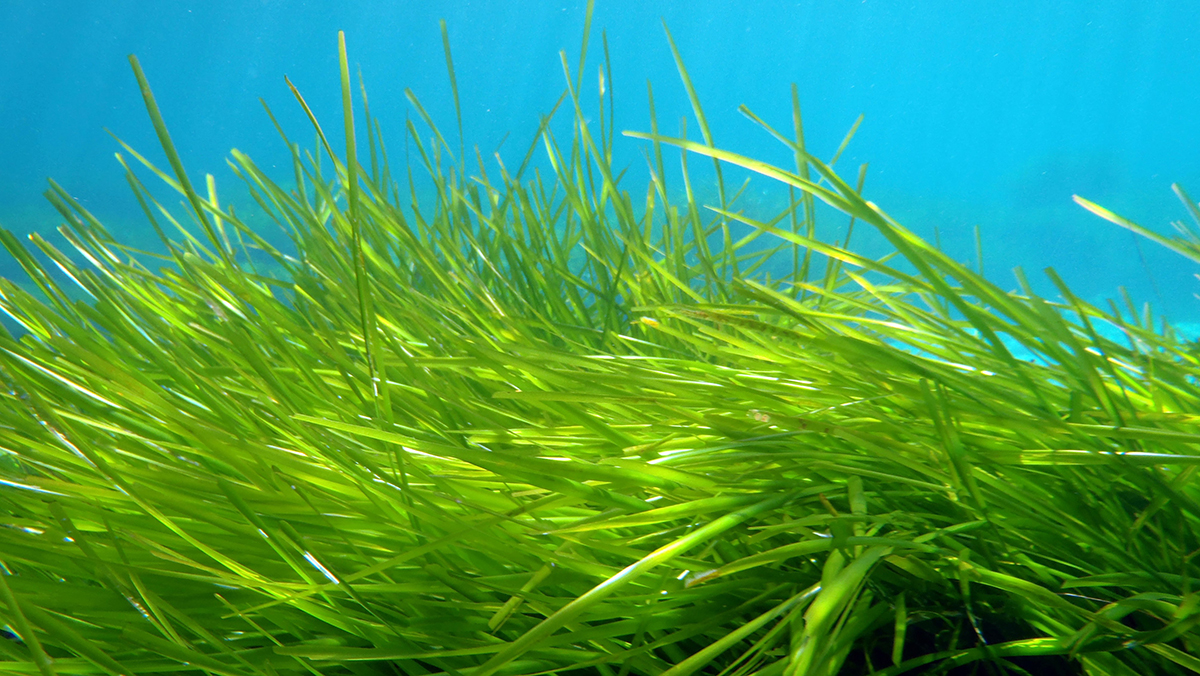
A recent study published in Nature has found sugar concentrations in the pore waters of sediments beneath Posidonia oceanica, a seagrass found in the Mediterranean Sea and commonly known as Mediterranean tapeweed or Neptune grass, to be about 80 times higher than previously observed. Posidonia oceanica secretes this sugar into the sediment beneath it.
It’s a finding that will help increase the understanding of what’s going on in the sediment below and around seagrass root systems, which in turn could help improve seagrass conservation approaches in the future.
Supporter Spotlight
“Sucrose is a sugar that we would use to sweeten our coffee in the mornings,” said Dr. Maggie Sogin, assistant professor in the Molecular Cell Biology Department at University of California, Merced, and lead author on the study. “One of the important things about sugar and sucrose itself is that microorganisms can gain a lot of energy and nutrition from that sugar molecule.”

Microbial colonies — organisms not visible to the naked eye that are critical to ecosystem function — often consume this sugar rapidly. In terrestrial environments, you would likely not detect sugar at such high concentrations because microbes are putting it to use. Therefore, Sogin was surprised to find so much sugar beneath seagrass.
The underground area beneath a plant where the root system interacts with the surrounding soil or sediment is called a “rhizosphere.” A lot less is known about these underwater rhizospheres in comparison to land-based rhizospheres.
A key difference is that oxygen is consumed very quickly by microbes in upper sediment layers in aquatic environments, so in much of the sediment there is no oxygen available. Sogin found during lab experiments that the microbial communities living in the rhizosphere do have the ability to break down sucrose, but they also have the ability to break down phenolics, a class of organic compounds. In the absence of oxygen, the presence of phenolics limits their capacity to break down the sugars.
Sogin’s ongoing work continues to investigate microbial communities in seagrass rhizospheres. She hypothesizes that since her team observed high sucrose levels under three other species of marine plants, the combination of a low-oxygen environment and plant-produced phenolics allows for things like sugar to amass in aquatic rhizospheres. Filling in the blanks of what’s going on in these rhizospheres can lead to improved management of seagrass meadows, a very valuable resource in aquatic ecosystems.
Supporter Spotlight
“If we can better understand the interactions that are occurring and how microbes help promote the health and metabolism and maintenance of seagrass meadows, then maybe we have a better way of thinking about how we can restore seagrass meadows or how we can protect them for future climate change scenarios,” Sogin said.
North Carolina has the most seagrass acreage on the Atlantic coast, but even these expansive meadows are not immune to long-term threats.
Dr. Jud Kenworthy worked for the National Oceanic and Atmospheric Administration for more than three decades. Retired from NOAA now, he continues to partner in a volunteer capacity with the Albemarle-Pamlico National Estuary Partnership, and is a adjunct member of the faculty at the University of North Carolina Wilmington.

Kenworthy was involved in the development of a submerged aquatic vegetation program in Beaufort through NOAA in the 1970s. He went on to work with seagrass for the majority of his career.
North Carolina, said Kenworthy, is a unique area when it comes to seagrass, but its role in the ecosystem is irreplaceable.
“It’s an incredible place because we have this mix of temperate and tropical species,” Kenworthy said.
North Carolina has a unique physical location with the Gulf Stream coming up from the south, and the Labrador Current flowing down from the north. As a result, you will find seagrasses at their northernmost and southernmost limits in North Carolina. From the standpoint of climate change, said Kenworthy, this makes North Carolina’s seagrass meadows a bit of a “living laboratory.”
Seagrass does a lot for the ecosystem. Its root systems hold sediment in place and protect the shoreline by preventing erosion. The structure it provides offers food and habitat to countless underwater species. Seagrass is a highly effective carbon sink, and helps improve water quality.
But seagrass also faces encroaching threats from pollution, climate change and urban development. APNEP research shows that between 2006 and 2013, total seagrass coverage decreased by about 5.6% in the Albemarle-Pamlico Estuary.
Kenworthy said it’s important to conserve seagrass because nothing else provides all the same ecosystem services to a comparable degree. There’s no equivalent substitute for it. And once it is gone, restoration has a really low rate of success.
“It’s hard and expensive to bring it back once we’ve lost it,” Kenworthy said. At their most effective, restoration efforts have a success rate of only 42%. “It’s not even as good as a flip of a coin.”







